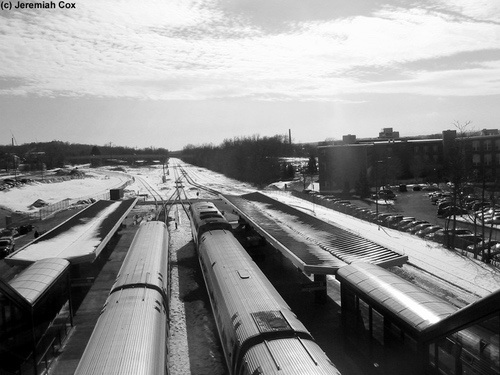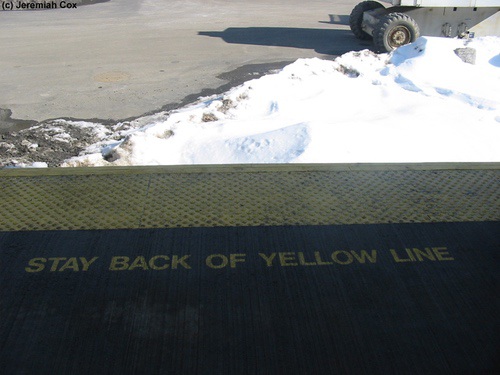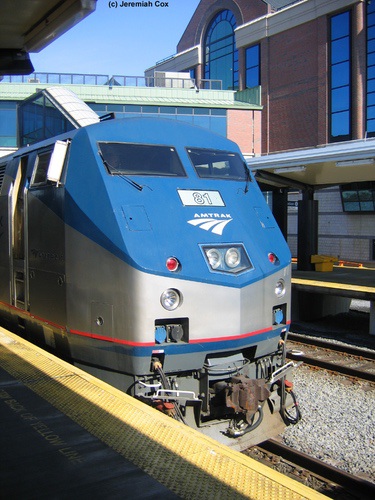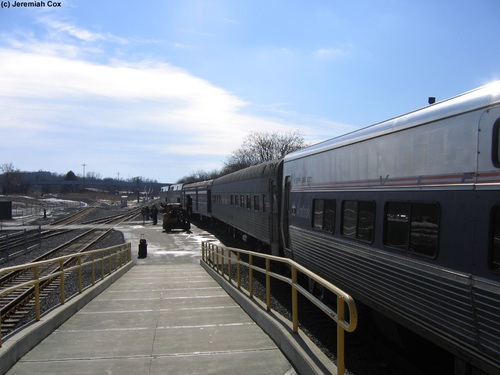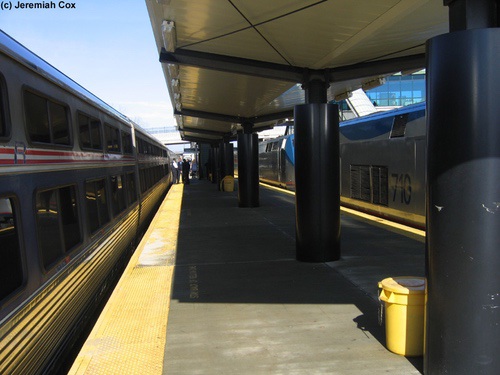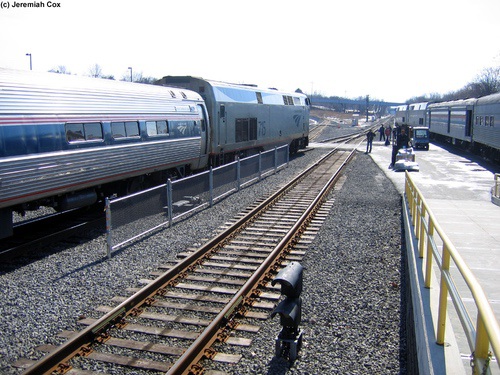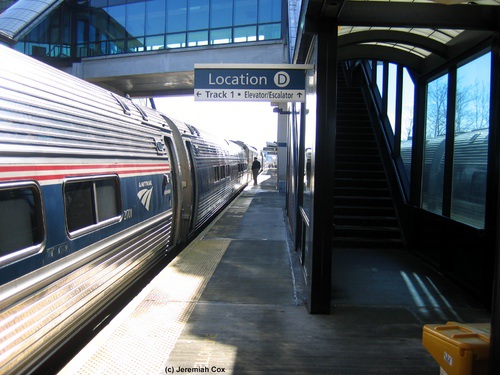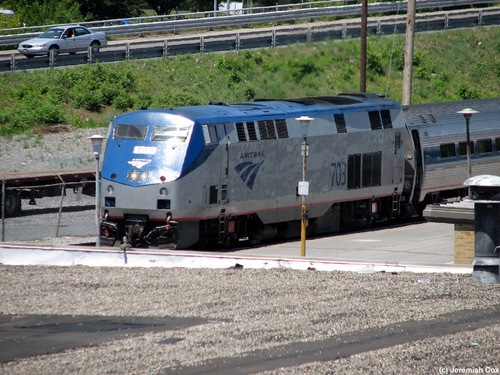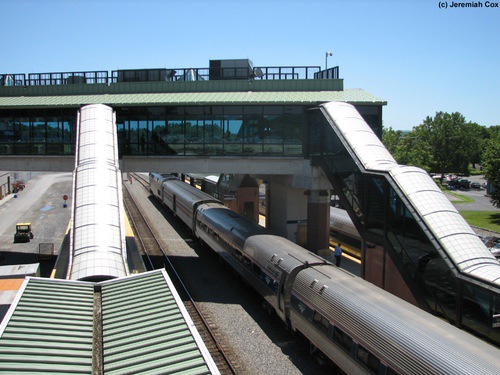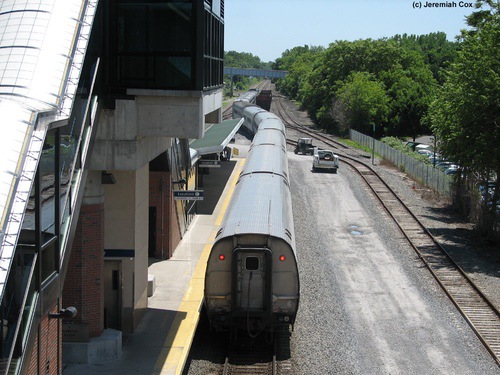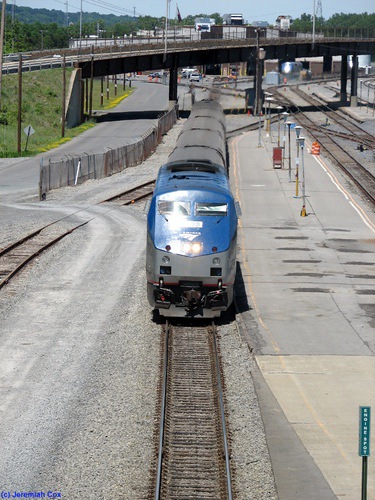

 Schenectady, NY Schenectady, NY | Adirondack | Hudson, NY  |
| Ethan Allen Express | ||
| Empire Service | ||
| Maple Leaf | ||
| Lake Shore Limited Train Combines/Divides |
Rhinecliff, NY  | |
Pittsfield, MA  |
Albany-Rensselaer is located on the east side of the Hudson River across from Albany, New York. It is an important station and a service stop and crew change point for all trains that stop there. The passenger station is just south of the Rensselaer Yards where Empire Service Trainsets are maintained. The station's core service is Empire Service trains that make 9 runs weekday and 7 per weekend from Albany down to New York City. Two of these trains per day are extended west to Niagara Falls.
The Empire Service trains are supplemented up the Hudson by the daily Maple Leaf that continues to Toronto, Adirondack to Montreal, and Ethan Allen Express to Rutland, Vermont. This makes 12 weekday trains to and from New York City. The Lake Shore Limited also serves the station. The combined Lake Shore Limited originates and terminates in Chicago, in Albany the train is divided or combined with the front half of the train continuing through or coming from Massachusetts to Boston (and is the only train service between Albany and Boston) and the rear half getting continuing down or coming up the Hudson to New York City. The New York section doesn't accept any intermediate passengers between New York and Albany (although as of 2024 passengers can use the Chicago-bound Lake Shore Limited for intermediate travel between New York and Albany). Travel is permitted from Albany on the Boston section in both directions since it is the only daily train (between 2003 and 2008 as a now ended cost-cutting measure the Boston section was a cross platform transfer with only coaches and the entire trainset continued to New York).
During the summer months on Fridays and Sundays only, the Berkshire Flyer also stops at Albany as a pilot program, running from New York to Pittsfield, MA. This train has to reverse in the station to get between the Water Level Route, and the Post Road Branch to the Berkshire Supdivision that it takes (following the route of the Boston section) on its summer seasonal trips to and from Pittsfield. This train began in 2022 as a pilot program.
The present location of a train station at this location in Rensselaer began in 1968 when the Penn Central Railroad abandoned the Albany Union Station across the river directly in Albany to allow the railyards to be relocated for I-787, the building is still standing, and relocated to Rensselaer across the Hudson.
Trains continuing west and north of Albany still cross the Hudson on the Livingston Avenue Bridge, that was originally only built for freight trains, just north of the station and curve around downtown. Two small stations predate today's modern station, the first small station was built by the Penn Central in 1968 and the second was a generic AmStation built in 1980. This AmStation looked very similar to that found in Rochester (see older photos on this page). It was a single story brown brick building with an overhanging flat black roof.
Today's modern station opened on September 22, 2002. The station was completed a few months sooner but disagreements between Amtrak and CDTA (the local transit district and owner of the station) over rent and other cost related measures delayed its opening [1]. The two original stations were demolished after fits and starts that finally began in October 2010. Demolishing the former station buildings was the first step in building a forth track through the station that was finally compelted in 2018. Before the 4th track was added, trains were delayed waiting for a track to open up in the station to discharge or receive passengers.
The modern station is just south of the where the previous two once were and is a multi-story brick glass building building with the entrance on the top story with an extremely high ceiling. Passengers enter the station through either of two sets of doors from the top of a three story parking deck. The roof of this parking deck is at the samae level as Herrick Street that crosses over the northern half of the train platforms on an overpass.
Inside is an extremely airy station with a cathedral ceiling and glass letting plenty of light inside. There are two sets of doors from the street inside. Inside the station is a cafe, a convenience store, rental car agency and the Amtrak ticket counters that include checked baggage for the Lake Shore Limited directly at them. There is also a US Post Office. There is a small area of seating but not all that much compared to larger stations for waiting passengers. Towards the northern end of the depot is where a glass enclosed pedestrian overpass leads out to the platforms. Inside the pedestrian overpass is more seating for waiting passengers. Although as of 2025 when I visited the station this area was only for ticketed pasengers to line-up with staff preventing passengers from entering the overpass unless their train was boarding.
A staircase, escalator (that changes direction depending upon if a train is boarding or discharging passengers) and elevator leads down to each of the two platforms. The platforms are restricted access with ticketed passengers only allowed onto them when their train has arrived in the station and it is boarding. Boarding is announced in the station and a times in the station's existance tickets have been checked at the top of the escalator. Since the station is service stop on through trains their is still plenty of time to mill about on the platforms.
The modern station when it opened has two high-level platforms that can accommodate 7 cars and end with wide gradual ramps down to track level, signs at the ramps say Restricted Area. The sides of both platforms have tactile warning strips that were originally designed for 4 tracks although there are presently just 3 tracks in the station with the west platform and island for Tracks 1 and 2 and the east platform a side platform just for Track A. The full length of the platforms have modern canopies is wide brick supports. The northern end of the platforms all extend north at ground level. Along the low-level portion of track 2 a yellow tactile warning strip has been installed and a wheelchair mobile lift is available. This low-level platform is used when the combined Westbound Lake Shore Limited #49/449 to Chicago with 11 passenger cars and two baggage cars is combined in the station. The Eastbound Lake Shore Limited #48 to New York and #448 to Boston is separated before each section stops in the station and the low-level platform doesn't have to be used. These low-level platforms are the remains of the original station platforms and the AmStation was just across from them (passengers crossed from the AmStation to the platforms via track level grade crossings).
A new 4th track, and much longer high-level platforms, were opened in stages in 2017 and 2018. Today, the station has two platforms, the platform closest to the depot can accommodate 11 cars for what are now numbered Tracks 1 and 3. The high-level platform for the other two tracks is slighlty shorter and can accommodate 9 cars. The platforms are nearly fully canopied with the same black beam styled canopies as the rest of the station extended to cover the lengths of the new platform. There are modern Albany-Rennselaer, silver with blue text Amtrak signs along the platform now. The station opened with very few proper platform name signs, just a couple of Albany-Rensselaer signs on the edge of the pillars that hold up the pedestrian overpass and entrance to the platforms
Photos 1-9: February 15, 2005; 10-20: July 14, 2006; 21 & 22: December 30, 2005; 23-34: July 21, 2006; 35-37: August 17, 2006; 38-62: July 14, 2008; 63-73: July 13, 2009; 74-136: April 5, 2013; 137 & 138: October 7, 2013; 139-145: October 24, 2013; 146-159: October 27, 2013; 160-171: February 12, 2015; 172-224: May 12, 2025;
